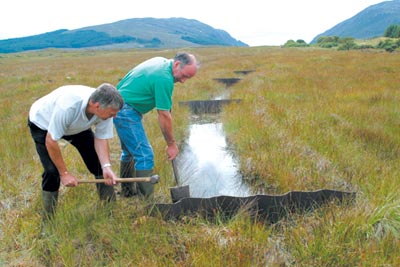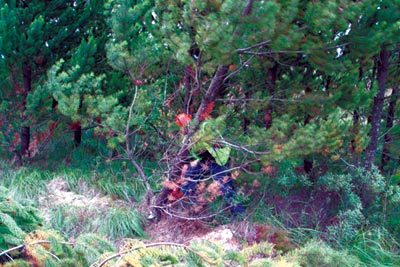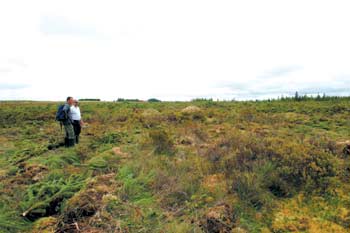| 2004 |

|
YEAR BOOK |
Coillte
|
The restoration of blanket bog in Ireland
|

Felling of planted areas with tall, closed-canopy conifers
In these areas, the timber is being extracted by conventional harvesting methods. Trees are being removed and afterwards the ground surface is covered with a mixture of wide brash mats, and areas with a patchy cover of brash remain after harvesting. As there is generally little bog vegetation remaining in areas which have been under tall conifers for 30 to 40 years, it is anticipated that recovery of bog vegetation at these sites will be slow, especially in the short term.

Felling of planted areas with low, sparse conifers
At many sites, there are areas of conifer plantation which are small in stature either due to their young age or due to poor growth rates. As a result of the trees in these areas not having achieved a closed canopy, there is usually a high cover of bog vegetation, mostly dominated by either purple moor-grass or ling heather. Most of the trees in these areas are being felled manually by chainsaw and left on site. In order to increase the area of open ground at these sites, the felled trees are being wind-rowed. At a couple of sites in Co. Mayo the felled trees are being chipped by machine. The chipping and wind-rowing of trees clears the ground surface of woody material, which facilitates the more rapid recovery of the bog vegetation. The prospects for the recovery of bog vegetation in these areas are generally good.
Felling of regenerating conifers
If a blanket bog surface is drying out, it may be prone to colonisation from conifers seeding in from adjacent areas of plantation. In such areas, there is generally a low density of trees present and, as a result, these trees can be removed by manual felling. The felling of conifers regenerating on intact blanket bog is being carried out at a number of sites in the Slieve Blooms.

Blocking of drains
Any active drains within the site areas are being dammed, by hand, using interlocking plastic piling dams. The blocking of drains with peat is also being carried out at a number of sites. This blocking of drains will slow water movement and thus reduce the rate of water loss from the sites. This reduction in the rate of water loss will, in turn, lead to an elevation of water levels in the surrounding areas and assist the restoration of bog. The damming of drains is being carried out to varying extents at all sites, and the changes in water levels within the peat are being assessed using a number of Water Level Range Gauges (WaLRaGs).
The efficacy of these various restoration measures is being monitored over the lifetime of the project. Changes in the vegetation will be monitored by means of permanent plots which will be surveyed at regular intervals. The quality of water in streams which flow out of felled areas is also being monitored at a number of locations. Although the rehabilitation of active blanket bog habitat may take decades to achieve at some of the sites, it is anticipated that, by the end of this project, the regeneration of blanket bog vegetation will be well progressed. Another important aspect of this project is that it will provide valuable information concerning the practicalities of blanket bog restoration in Ireland. This information will be of considerable value to any future bog restoration programmes in the country. Work on this project began in July 2002 and will run until June 2006.
Contact: Kevin Donnellan � Project Manager;
Tel: 090 9741683; E-mail: [email protected] ;
Caroline White � Public Relations/Administration Manager;
Tel: 071 9162663; E-mail: [email protected]